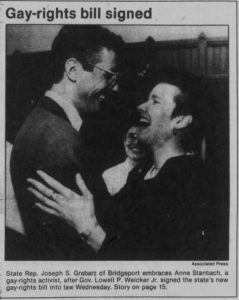By Emma Wiley
On May 1, 1991, Connecticut Governor Lowell P. Weicker Jr. signed into law Public Act No. 91-58, “An Act Concerning Discrimination on the Basis of Sexual Orientation.” Colloquially known as the “gay-rights bill,” this legislation prohibited discrimination based on sexual orientation in housing, employment, and credit. It was one of the first LGBTQ+ civil rights laws in the state of Connecticut. The passage of the 1991 gay-rights law, however, was the culmination of years of persistent advocacy and failed legislation, starting in 1973.
The Struggle for Gay Rights Legislation

Rally held at the State Capitol in Hartford to protest the General Assembly defeat of a bill to ban discrimination against homosexuals. Some participants wore white masks to protect their identity (June 3, 1987) – Hartford Courant
The gay rights movement and broader fight for LGBTQ+ rights did not start in the 1970s, but the Connecticut legislature introduced the first version of the gay-rights bill in 1973. In 1975, Connecticut’s Senate became the first legislative chamber in the country to pass an anti-discrimination gay-rights bill, however, the House of Representatives then rejected it. Over the next 16 years, various iterations of a gay-rights bill failed in the General Assembly.
As the fight over gay rights and anti-discrimination legislation continued through the 1970s and 1980s, advocacy groups formed on both sides of the issue. The Connecticut Citizens for Decency took out quarter-page advertisements in the Hartford Courant to promote their opinions against homosexuality and arrived at public hearings wearing blue berets and carrying Bibles to testify to their opposition. On the other side, the Connecticut Coalition for Gay and Lesbian Rights and other gay rights activist groups lobbied legislators and organized protests and vigils in support of the gay-rights bills.

Capitol police approach a demonstrator in the gallery of the House chamber. Several hundred people, who were supporting the Connecticut Coalition for Lesbian and Gay Civil Rights, also demonstrated outside the State Capitol (June 8, 1989) – Hartford Courant
After the murder of Richard Reihl, a gay Wethersfield man, in May 1988, the Connecticut LGBTQ+ community began to push more urgently for civil rights and protections. While the gay rights movement had been active for years, anger over Reihl’s murder—in addition to the ongoing AIDS epidemic—galvanized activists.
Proponents of the gay-rights bill became more and more frustrated after years of failed legislation. The 1987 bill got the closest to becoming law, rejected after a 73-73 tie in the House. After the General Assembly rejected the 1989 version of the bill, more than three hundred activists protested outside the State Capitol. Several dozen protestors made it into the gallery, where they hung banners that read “We refuse to disappear” and listed the names of the legislators who had voted against the gay-rights bill. Several months later, in February 1990, Capitol Police arrested 12 members of the Coalition after they interrupted Governor William O’Neill’s budget speech to the General Assembly by unfolding a banner in the gallery that demanded lesbian and gay rights.
The 1991 Gay Rights Bill
Even though numerous gay-rights bills failed over 18 years, several different factors contributed to the successful passage of the 1991 bill. The opposition of the Roman Catholic Church was one of the largest barriers in previous years. The 1991 bill, however, included exemptions for religious institutions and the Catholic bishops opted not to oppose the legislation at the public hearing as they had in the past. Even though the Roman Catholic Church was conspicuously absent, both proponents and opponents voiced their support and concerns at the public hearings and packed the gallery during the floor debates.
In addition to sustained efforts and increased visibility of the LGBTQ+ community, in December 1990, state Rep. Joseph Grabarz Jr. (D-Bridgeport) publicly announced that he was gay, becoming the first openly homosexual state lawmaker in Connecticut. As more public figures came out as gay or lesbian, it became harder for legislators to claim they did not see the need for the bill because they had never met a homosexual person. During the House debate over this bill, after listening to some of his colleagues refer to homosexuality as “wrong,” Rep. Grabarz took the floor and said, “it’s not everyday that someone gets to travel to their place of employment, as I did today, to hear their fellow co-workers and colleagues debate the protection of their civil rights and so if I actually appear a little nervous, I am.”

Rep. Joseph Grabarz embraces Anne Stanbach, a gay-rights activist, after gay-rights bill signed into law (May 1, 1991) – Record-Journal (Meriden)
On April 17, 1991, the Senate made history when it passed the bill by a vote of 21 to 14, days after the House of Representatives passed it by a vote of 81 to 65. With the passage of the law, Connecticut became the fourth state to prohibit discrimination against homosexuals—after Wisconsin, Massachusetts, and Hawaii.
The 1991 gay-rights law was a significant milestone for the LGBTQ+ community in Connecticut, but it also included several exemptions for religious organizations, ROTC, owner-occupied multiple family homes, and child adoption/foster situations. In addition, the law makes it very clear that “nothing in this act shall be deemed or construed to mean the state of Connecticut condones homosexuality or bisexuality or any equivalent lifestyle.” In the following years, Connecticut’s LGBTQ+ community continued to advocate for acceptance and rights such as marriage equality and protections for transgender people—a great number of these fights continue to this day.
Emma Wiley is the Digital Humanities Assistant at CT Humanities and holds a B.A. in History from Vassar College.









